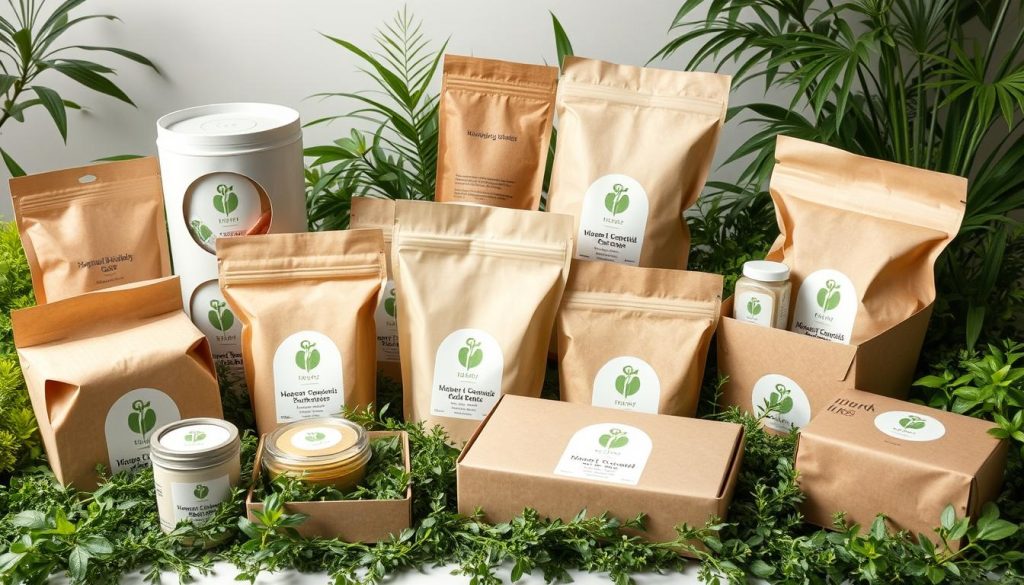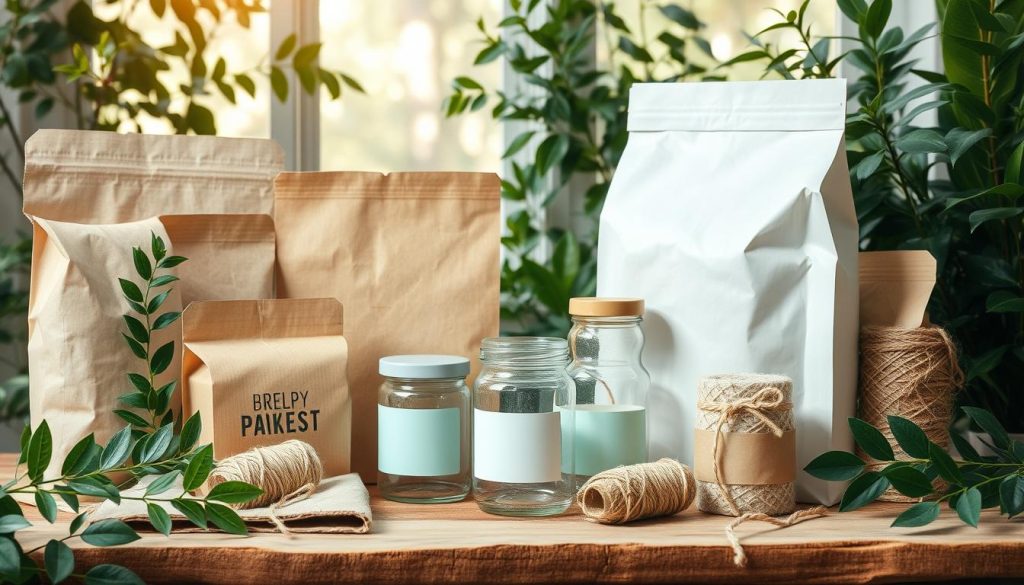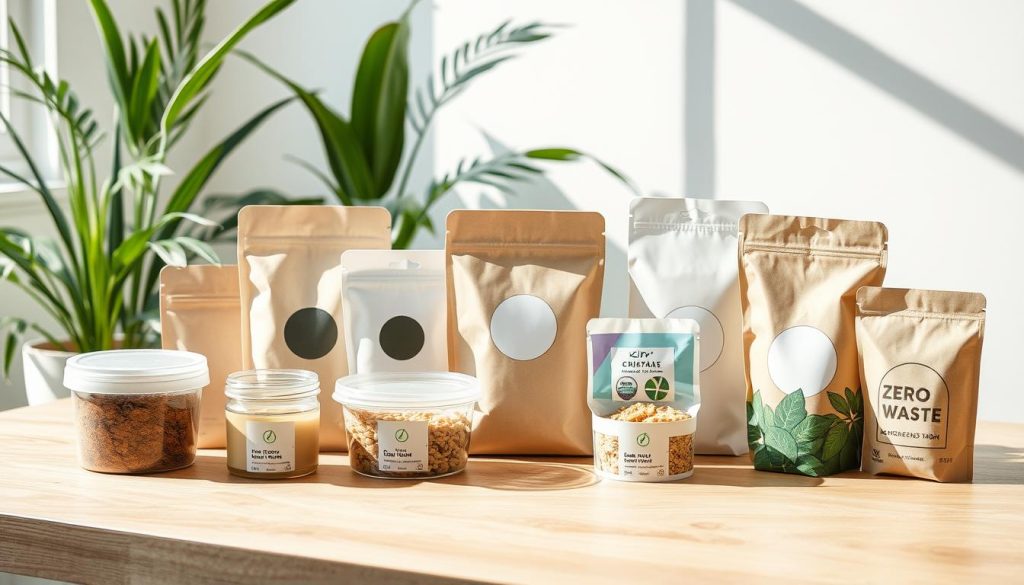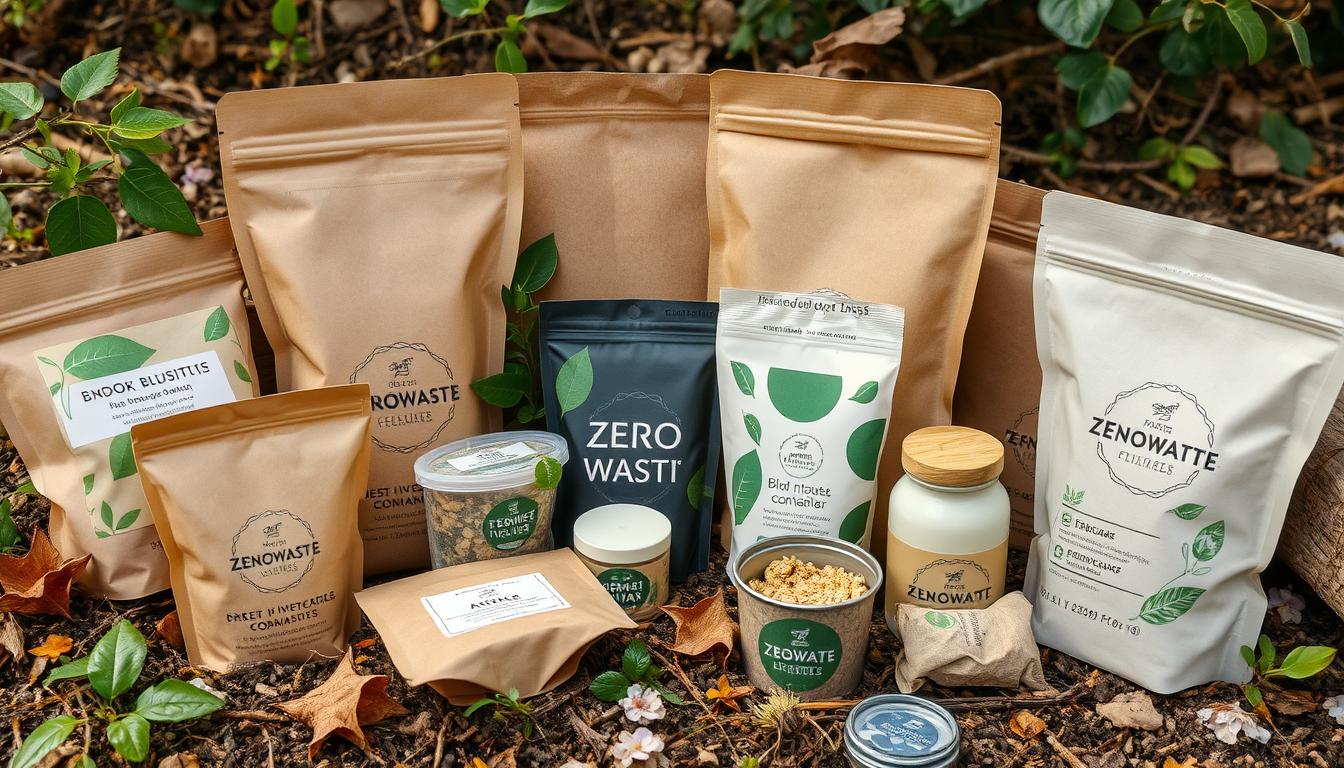I’m excited to share my knowledge on eco-friendly zero waste packaging design. Today, the need for green packaging is huge. People want brands that care about the planet, and zero waste packaging is key.
As a packaging designer, I’ve found that zero waste is more than just cutting down on waste. It’s about changing how we think about packaging from start to finish. In this article, I’ll explain the basics of zero waste packaging. I’ll also share my experiences and offer tips for making your packaging more sustainable.
Understanding Zero Waste Packaging Design
Zero waste packaging design is key to a sustainable future. It changes how we think about packaging. Instead of making things then throwing them away, we aim to reuse and recycle materials.
What is Zero Waste Packaging?
Zero waste packaging means making packaging that doesn’t harm the environment. It should be biodegradable, compostable, or recyclable. The idea is to use packaging that can be reused, not thrown away.
This fits with the circular economy idea. It sees waste as something valuable to use again in making new things.
The Importance of Sustainable Practices
- Reducing waste and environmental impact: Zero waste packaging helps reduce landfill and ocean waste. It makes our planet healthier.
- Promoting a circular economy: By making packaging reusable, we keep materials in use. This saves resources and supports a sustainable economy.
- Meeting consumer demand: People want brands that care about the environment. This demand grows for zero waste packaging.
Adopting zero waste packaging is vital for reducing waste and creating a sustainable future. By changing how we design and use packaging, we help the planet. We move towards a circular economy and protect our world for future generations.
My Journey Towards Zero Waste Packaging
I’ve always been passionate about finding sustainable packaging solutions. My journey to zero waste packaging has been both tough and rewarding. I’ve found new ways to use renewable resources and sustainable materials, which has really inspired me.
Initial Challenges I Faced
At first, many people doubted the idea of zero waste packaging. They thought it was too expensive and not practical. But I was determined to show them it was possible to reduce waste.
Discovering Sustainable Materials
Then, I found amazing sustainable materials. They were not only good for the planet but also looked great. We started using biodegradable plastics and compostable paper, which changed everything.
Learning from Successful Brands
I’ve learned a lot from brands like Lush and Package Free Shop. They showed me how to make packaging that’s both beautiful and eco-friendly. Their success has helped me improve my own packaging ideas.
Key Principles of Zero Waste Packaging Design

Creating zero-waste packaging is more than just using recycled materials. It’s about understanding a product’s whole life cycle. Two main principles are minimalism and making things reusable and recyclable.
Minimalism in Packaging
Minimalism is a key part of zero-waste packaging. It means using only what’s needed to protect the product. This way, we use fewer resources and make less waste.
Minimalist packaging also looks clean and modern. This appeals to people who care about the environment.
Designing for Reusability and Recycling
Another important part is making sure packaging can be reused or recycled. This means choosing materials like glass, aluminum, or certain plastics. It also means designing packaging that can be refilled or broken down for recycling.
By following these principles, designers can make sustainable packaging. This helps reduce waste and supports a circular economy. It’s all about looking at the whole life cycle of packaging.
Tips for Implementing Zero Waste Packaging

Switching to zero waste packaging needs careful thought. It’s about picking the right materials and working with suppliers who care about the planet. I’ve found that these two steps are crucial for success.
Choosing the Right Materials
The materials you choose are very important for zero waste packaging. Go for options that are biodegradable and compostable. Look into sustainable materials from Ecovative Design or biodegradable packaging from Notpla. They offer green alternatives to plastic.
Try to pick materials that can be recycled, reused, or disposed of safely. This way, your packaging won’t end up in landfills. By carefully picking your materials, you can meet your sustainability goals.
Collaborating with Eco-Friendly Suppliers
Zero waste packaging is a team effort. Look for suppliers who care about the environment as much as you do. They should focus on responsible sourcing and minimal waste.
- Find suppliers who offer sustainable materials and biodegradable packaging.
- Work with brands and manufacturers who share your eco-friendly vision.
- Make sure there’s open communication in the supply chain to meet your zero waste goals.
By teaming up with eco-friendly suppliers, you can make sure your packaging fits your green vision. This way, you’ll give your customers a zero waste experience.
Real-Life Examples of Zero Waste Success

I’m always excited to see brands leading in sustainable packaging. Seed Phytonutrients and Loop are two that really stand out. They’ve come up with designs that greatly reduce their environmental impact.
Brands That Inspire Me
Seed Phytonutrients focuses on natural hair and skincare products. Their packaging is made from recycled materials and is designed for reuse. This lets customers refill their products, cutting down on waste.
Loop is another brand that impresses me. It’s changing how we use everyday items. Loop works with big brands to offer products in reusable packaging. This closed-loop system gets rid of single-use waste.
Innovative Designs I Admire
Seed Phytonutrients’ shower-friendly paper bottle is a standout. It’s a water-resistant paper container that can be recycled or composted. This shows how creative solutions can lead to sustainable changes.
Loop’s reusable containers for things like toothpaste and ice cream are also impressive. They make us think differently about single-use packaging. These containers are durable and look great, showing us a more sustainable future is possible.
The Future of Zero Waste Packaging Design
The world is waking up to the harm packaging causes. The future of zero waste packaging looks bright. We’ll see more use of edible and biodegradable materials. The circular economy will be key in shaping the industry.
Trends to Watch
Edible packaging is an exciting trend. Companies like Evoware and WikiCell are using seaweed and plant-based materials. This makes packaging that can be eaten or composted, reducing waste.
Biodegradable materials are also advancing. Made from agricultural waste or microbes, they’re changing the game. Brands like Ecovative and Stora Enso are leading this change, making packaging more eco-friendly.
My Vision for Sustainable Packaging
I dream of a future where people make eco-friendly choices. I see a world where packaging’s environmental impact is clear. Together, we can make packaging sustainable, using renewable resources and promoting recycling.

